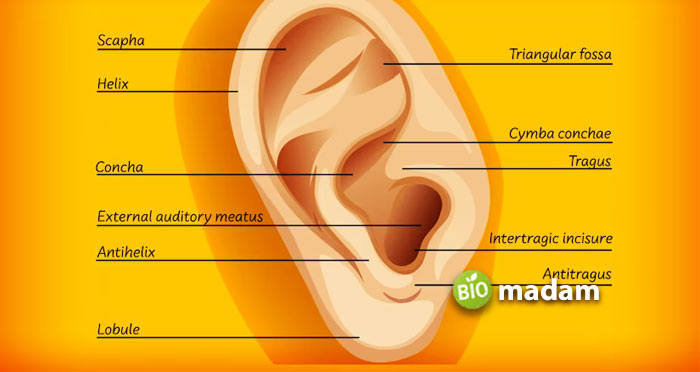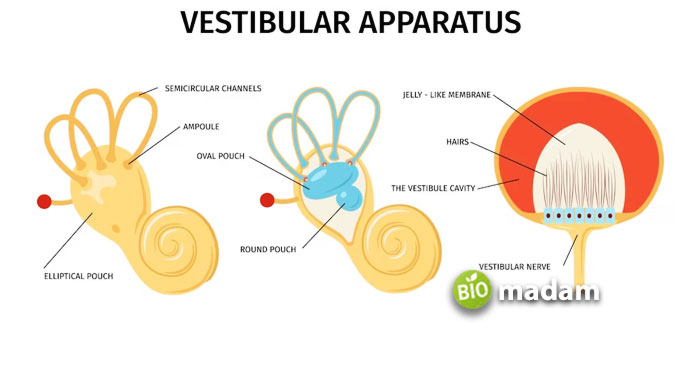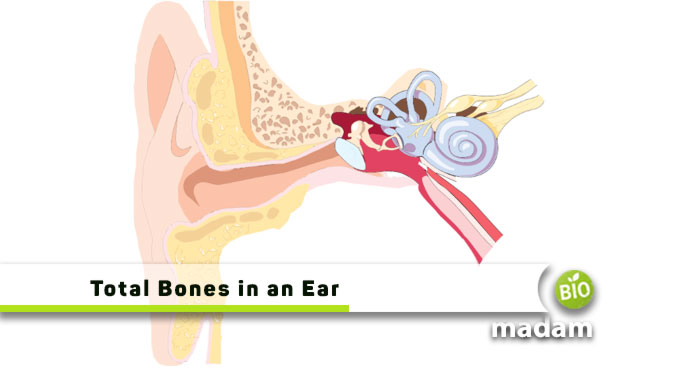The human body is a marvel of nature. Complex organ systems have individual organs with tissues that are intricately designed. These organs work in coordination with each other to sustain life. Each organ is responsible for performing its distinct function, and each of these functions is extremely important for keeping us alive. As the heart pumps blood through our body, the brain controls all our bodily functions and thoughts, and the right and left lungs help us in breathing. Similarly, our five senses are also controlled by different organs of our body. We see with our eyes, touch with our hands, smell with our noses, taste with our tongues, and hear with our ears.
The ears are also a complex part of the body consisting of functions other than hearing. Our hands, feet, and other body parts comprise bones. The human body has a total of 206 bones. But have you ever wondered how many bones are in your ear? Let’s find out more about this unique part of the body.
What is an Ear?
An ear is a sensory organ used for hearing and maintaining the balance of the body. There are two ears present on each side of the head. They work in coordination to detect, transmit, and analyze sound. There are three parts of the ear. These include the outer or external ear, the middle ear, and the inner ear. Each of these parts performs different functions which will be discussed later on.

How Many Bones are in your Ear?
The bones of the ear are also known as ‘’ossicles’’ which are three in number. Just like other bones functioning in the skeletal system, these three have their specific functions too.
Malleus
It is the largest of all bones found in the middle ear. Malleus resembles the shape of a hammer, thus, known as a ”hammer.” Malleus has a diameter of 8 millimeters. It is attached to the eardrum and is responsible for sending sound waves to the inner ear. Sound waves are first sent to the incus, and from there, it is sent to the stapes.
Incus
Sound waves produce vibrations in the ears, these vibrations are also called ‘’oscillations.’’ These vibrations pass through the outer ear and the inner ear, and then reach the cochlea. Here at the cochlea, these oscillations are converted to central nervous impulses and are relayed to the brain. Incus connects the malleus and stapes. It transmits the vibrations from the malleus to the stapes. Incus is also known as ”the anvil,” as this bone is formed as an anvil.
Stapes
Stapes, also known as ”stirrup” is the smallest bone found in the human body. It is the most important bone of the ear. If your stapes are damaged, your hearing will be impaired. There are two divisions on the stapes responsible for transmitting sound waves to the flat bottom of the ear. These vibrations are then sent to the inner ear where these vibrations are converted to neuronal information. This information is then sent to the brain via cochlear and auditory nerves.
Parts of an Ear
The human ear consists of three main parts:
Outer Ear
It is the outermost and most visible part of the ear. Auricle and pinna are two other names for the outer ear. This part of the ear consists of ridged cartilage, skin, and glands. These glands secrete earwax. The funnel-shaped canal of the outer ear leads to the eardrum.
Middle Ear
The middle ear is present on the other side of the eardrum. Malleus, incus, and stapes are the three bones present in the middle ear. These bones pass the sound waves from the eardrum to the inner ear. The middle ear has eustachian tubes as well to maintain the air pressure in the ears.
Inner Ear
The inner ear consists of two main parts, cochlea, and semicircular canals. When sound waves enter the cochlea, the fluid and hair inside it begin to vibrate. These vibrations are converted to electrical signals which are then sent to the brain. The semicircular canals are responsible for maintaining the balance of the body.
What are the Functions of the Ear?
There are two main functions of the ear:
Hearing
Sound waves enter the outer ear via the ear canal and produce vibrations in the tympanic membrane. These vibrations are then passed on to the middle ear with the help of three bones. These bones or ossicles send the sound waves to the inner ear. There are tiny hair cells in the inner ear, called stereocilia. These cells transform the vibrations into electrical energy. This electrical energy is sent to the brain by the auditory nerve fibers.
Balance

Another important function of the ear is to maintain the balance of the body. This is done by the inner ear. There are semicircular canals in the inner ear that are filled with fluid and lined with hair-like sensors. The fluid in these canals splashes around and moves the hair whenever you move your head. These hairs send the information to the brain through the vestibular nerve. The brain then sends the signals to the muscles guiding them to stay balanced.
Bottom Line
Our bodies are made of different organs working in coordination to keep us alive. Each of these organs is responsible for conducting its functions, where some are defined to control our five senses, including hearing through the ear. The ears help a body maintain balance via three bones, i.e., malleus, incus, and stapes. Moreover, the sound waves that travel to make hearing ways for us are in the form of vibrations. These vibrations travel straight from the malleus to the incus and finally the stapes.

Meet me; I am Paulina Zaniewska, who’s more hooked on providing the best health blog. I’ve always been so determined to compete as a nutritionist, and here I am, done with a Master’s in food technology. My brilliant performance throughout encouraged me to help people.

